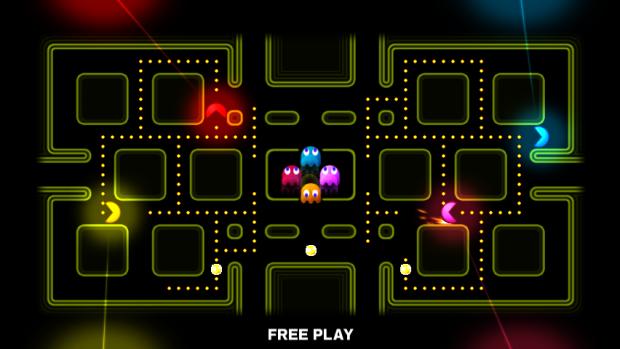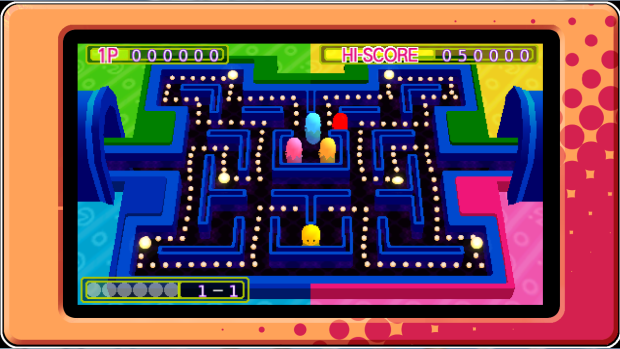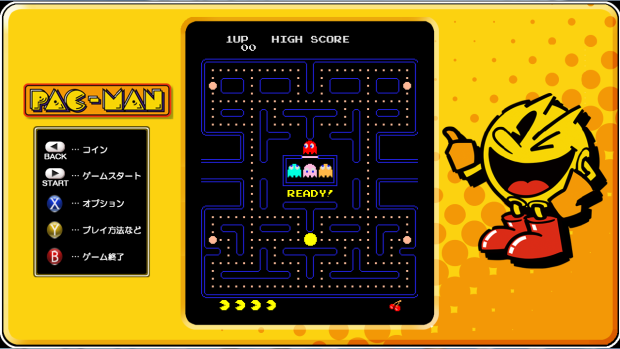Pac-Man Museum Review
What does Pac-Man mean to you? For this scribe, it means early memories of frantic ghost avoidance, “wocka wocka”, and the bright and colourful platforming of Pac-Land, based on some cartoon I never actually saw. When I was a kid the hungry yellow disc was everywhere – in sweet shops, in comics, and most prevalently in the arcades, where Namco (and Midway, lest we forget) tried to repeat the success of the magical original with a succession of sequels and re-imaginings. Pac-Man Museum sees Namco dust off over thirty years worth of these coin-op sequels, tie-ins and re-imaginings, throws in a few console games of note for good measure, and allows us to scrutinise some of the landmarks in the life of their iconic character. As with all retro compilations, this isn’t without its problems, and yet again sees Namco sail frustratingly close to Pac-fection.
It hits you immediately that the original Pac-Man game is still an excellently playable affair, a true arcade Hall of Famer that eschews overcomplicating matters in favour of tight gameplay, a logical scoring system and visuals that are the epitome of functionality. The simplicity of the original template begins to dilute the further you go down the list of games.

Super Pac-Man was Namco’s first in-house stab at a sequel, and features a confusing set of mechanics, involving collecting keys to open doors, and collecting food and other sundry items instead of the pellets that were the basis of the original maze premise. Pac & Pal is an even stranger beast. An extremely rare and seldom seen entry in the series that was only ever released in Japan, it retains the maze gameplay but again abandons the pellets, this time in favour of flipping over playing cards which then reveal items corresponding to the picture on the card. It introduces a friendly green ghost (the titular “Pal”), and power ups that allow you to shoot at the hostile ghosts to stun them and accumulate points bonuses. There are only so many ways you can present a hungry yellow dot eating dots in a maze, admittedly – but in changing things so dramatically, Super Pac-Man and Pac & Pal are both far too off-the wall to warrant sustained attention. They are also frustratingly difficult.
High difficulty is not a criticism you can level at Pac-Land, the simple yet loveable platformer that I so enjoyed playing as a five year old whippersnapper. In a sad coincidence, the arcade in which I first dodged ghosts in flying saucers, hopped over cacti and tried desperately to get back to Ms Pac-Man and Baby Pac-Man, is currently being demolished. The emulation here is of course spot-on, with the modern control scheme far more preferable than the all-button original cabinet scheme.

Pac-Mania was the final Pac-Man coin op of the 1980s, and heralded a lack of pellet gobbling presence in the arcades until nearly a decade later. Changing things dramatically one again, this one sees Pac-Man viewed isometrically, and while it was considered groundbreaking at the time , with some decent home conversions, played in the cold, harsh light of present day it is clunky and not a patch on the game that inspired it. Similarly poor are the Puyo-Puyo clone Pac-Attack (the Megadrive version features here) and 1996 Arrangement remake, which adds boss battles and a series of confusing power ups.
Thankfully the whole package is redeemed somewhat by the inclusion of the always-stunning Pac-Man Championship Edition, but most importantly the excellent and previously arcade-only Battle Royale, which almost justifies the entrance fee alone. Originally released as a celebratory anniversary four-player arcade cab, it features competitive multiplayer action that was terrific fun in its original incarnation and is equally as fun here. Set across a series of quick-fire rounds, you compete with AI or human-controlled Pac-Men in a battle for superiority, with performance gauges on points scored, ghosts eaten, and who manages to survive each round. Power Pills transform you into the giant-sized Super form first witnessed in the misfiring Super Pac-Man, allowing you to ingest your opponents to win the round.

Any decent retro compilation lives and dies by not only the games within, but by the presentation and emulation. Museum looks very nice on the surface – however the majority of the games, particularly the ancient ones, are displayed in an annoying, bordered letterbox format. There are no options to change the aspect ratio, and only dipswitch settings to tinker with. There are some nice in-game achievements to work towards, and some unlockable stickers and artwork, however for such an iconic series this could have been a brilliant opportunity to include some historic information on the games contained – things like original arcade flyers, a bit of background – anything. When you consider that the gold standard for arcade collections – for my money, any road – remains the comprehensive, sublime, yet NTSC-only Taito Memories packages for PS2, Namco are so far away from this level of quality and reverence for their source material that it hurts.
VERDICT: Yet again Namco have neglected to include the very best that their series have to offer, with no Championship Edition DX, and Ms Pac Man – arguably the killer Pac-Man title of the retro era – available as downloadable content only (although in fairness this is free for a limited time). As it stands, this is a handful of decent titles, poorly presented, with a bunch of curios you are unlikely to want to play. You cannot help but think that a more fitting tribute to the little yellow fella would have been a standalone version of the top-drawer Battle Royale, with the inclusion of online play that they have bafflingly ignored.

DECENT. A 6/10 indicates that, while this game could be much better, it still has a fair amount to offer the player. It might be an interesting title sabotaged by its own ambition, or a game denied greater praise by some questionable design choices. Don’t avoid it outright, but approach it with caution.
Review code provided by publisher.




